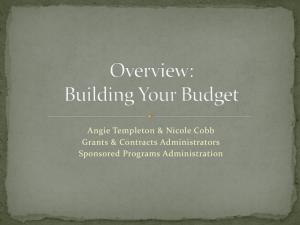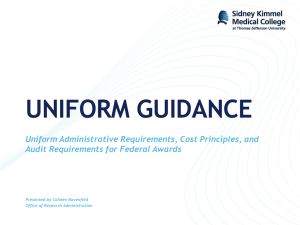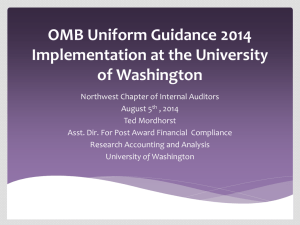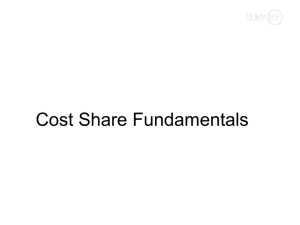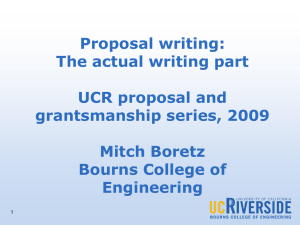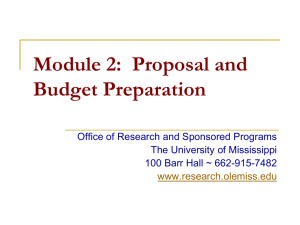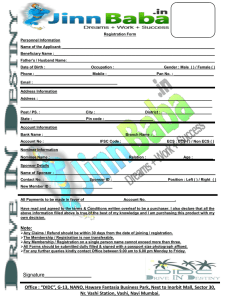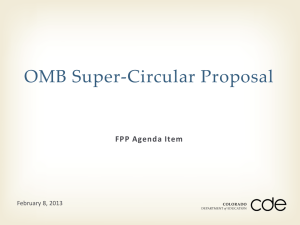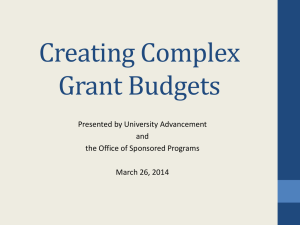Introduction to Budgeting
advertisement
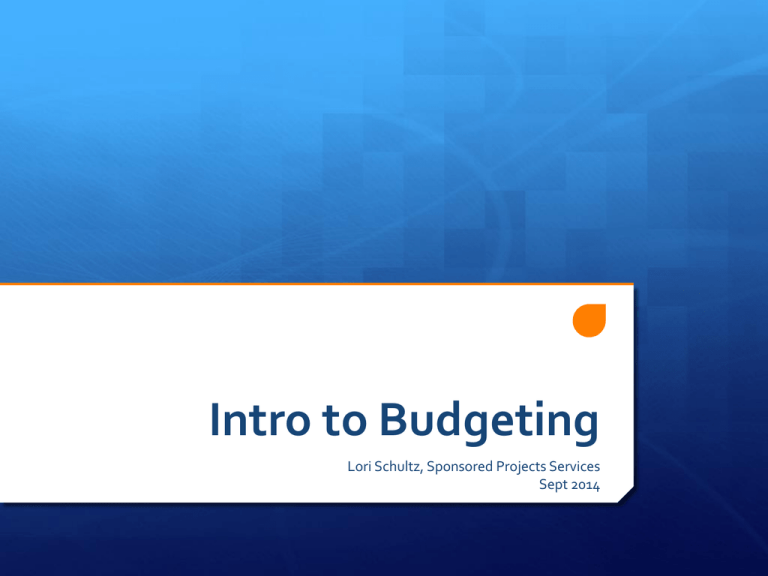
Intro to Budgeting Lori Schultz, Sponsored Projects Services Sept 2014 Today’s Agenda Where do we start? Basic framework for budgeting in sponsored research OMB Circular A-21 General Costing Principles The rules Mechanics of building a budget Categories of costs Common Issues Preparing the budget Where do we start? Program/Sponsor restrictions Total dollar limits Unallowed items of cost Required items of cost Cost sharing F&A Who else is involved? Other units/PIs? Deadline Sponsor Format Relative difficulty (have we done this before?) Mechanics of Building a Budget What can I charge? Budget & Justification should make sense when read along with the science Rules for federal awards The specific RFP may prohibit or require certain classes of expenses OMB Circular A-21 (Federal Rules) What is/was it? OMB: Office of Management and Budget Cost principles for federally sponsored projects Guidance for determining direct vs. indirect costs Replaced by OMB “Omni Circular” (2 CFR 200) on Dec. 26, 2013 No substantial change in cost principles Cost Principles Reasonable – OMB A.21, C.2(a) Allocable – OMB A.21, C.2(b) Consistent – OMB A.21, C.2(c) Allowable – OMB A.21, C.2(d) Direct vs. Indirect Costs Direct Costs Can be identified specifically with a particular sponsored project (OMB A-21 D.1.) Indirect Costs Facilities & Administrative Costs [F&A], Overhead (OMB A-21 E.1.) Incurred for common or joint objectives - cannot be identified readily and specifically with a particular sponsored project Administrative expenses (staff, supplies) Utilities Building renovations, maintenance Depreciation, debt service, central administration Direct vs. Indirect Costs Costs must be treated consistently - either as a direct or an F&A cost ‘Like costs treated in like manner’ Institution’s DS-2 often details which costs will be viewed as direct vs. indirect UA Direct/Indirect Cost policy: http://rgw.arizona.edu/sites/researchgateway/files/direct_and_indi rect_costs_of_sponsored_agreements_1.pdf Common direct cost questions Can I charge a computer/mobile device to my project? Yes – if being used in a programmatic way Connected to a scientific piece of equipment for data collection; Needed to run simulations, analyze data, etc. No – if being used in a general way Check email, browse internet, word processing, etc. Updated guidance is more flexible Not required to be dedicated to a single project ALWAYS ensure it is well-described in the justification Common direct cost questions Can I charge office supplies to my project? Typically no, due to lack of allocability However, they are allowable when in unlike circumstances Used in a programmatic way: conference materials, pamphlets, surveys, etc. Common direct cost questions Can I charge my administrative assistant to my project? Typically no, due to lack of allocability However is appropriate on a ‘major project’ Outside of general job duties Coordinating large numbers of collaborators or participants New guidance is more flexible here “Major projects” language removed, but requirement for allocability still exists Cost Sharing • Matching funds / in-kind contributions • Anything necessary for the completion of the project that is not paid for by the sponsor – College/dept/central funds to pay for salaries, portion of equipment, F&A restrictions, etc. • • Cash or in-kind • Cash: cost of cost-shared effort • In-Kind: reduced indirect cost rate 3rd party contributions Cost Sharing The general rule: DO NOT include cost sharing unless it is required by the program. When required, be sure it is clearly stated in budget & justifications Two categories: Committed – must be tracked Required by sponsor (committed in proposal) Not required, but committed in the proposal Uncommitted – does not need to be tracked ‘Volunteering’ of institution resources without mention of a specific dollar amount Cost Sharing & Allowability Remember reasonable, allocable, consistent, allowable? All of those apply! In general cost-shared expenses are subject to the SAME rules as direct expenses on the award: Allowable costs, allocable items Consistent & reasonable treatment Within project start/end dates Not otherwise prohibited by sponsor or program Cost Sharing & Allowability Sponsor F&A limitations: Is this cost share? Yes, but: Am I allowed to include it in my cost sharing total? Maybe, maybe not I have two related federal projects. Can I use my NSF funds as cost share for my USDA project? NO. Federal sources are almost never allowed as a cost share source. Getting started Usually best to start with a common format, even when the sponsor has forms: Review at multiple levels is easier Changes are easier Many sponsor formats don’t calculate except simple addition We’ll illustrate with the CALS format Direct Costs – Salaries – Fringe benefits / Employee Related Expenses – – – – (ERE) Travel Supplies Contractual/Services/Subcontracts Equipment Budget Basics - Categories Personnel Name/(TBD) and effort devoted to project % effort or person months (PM) PM = % effort X appointment, so: 10% effort for AY = 10% X 9mos = .9 person months Grad Students or Student workers : salary/stipend or hourly rate Salaries/hourly wages Current faculty/staff: Ask department To-be-hired: http://www.hr.arizona.edu/compensation_and_pay ERE rates http://rgw.arizona.edu/administration/institutional- information Budget Basics - Categories Personnel costs are the biggest portion of most budgets Most likely to be restricted: NIH Salary cap: $181,500 IBS (translates to full FY salary) http://grants.nih.gov/grants/policy/salcap_summary.htm NIH graduate compensation limit http://grants.nih.gov/grants/guide/notice-files/NOT-OD-02017.html NSF 2-months salary http://www.nsf.gov/pubs/policydocs/pappguide/nsf14001/gpg_2.js p#IIC2g Other sponsor restrictions Budget Basics – Categories Travel For budgeted project personnel Project-related conferences, required grant meetings, subrecipient site visits, field work, etc. Transportation, lodging, per diem, etc. Costs based on: Searching fares for providers (airline, etc) Historical costs for conferences (fees / hotel) Limits on lodging/per diem by location (http://policy.fso.arizona.edu/fsm/1400/1471) Budget Basics – Categories • Equipment – Defined by our rate agreement: • http://rgw.arizona.edu/administration/institutional-information • Tangible, non-expendable, useful life >1 year • Acquisition cost of $5,000+/unit • Depending on the program & cost of equipment • • • Formal quotes Informal quotes Acquisition cost includes tax, shipping, & installation Budget Basics - Categories • Materials and Supplies – Items to be used for the project • Ex: chemicals to be used for experimentation • Ex: printer paper for a research survey • Ex: computer to run a piece of lab equipment • Contractual – Services to be performed by another entity for the project • Ex: 3rd party vendor to perform DNA sequencing • Ex: evaluator to assess effectiveness of education program – Subaward Budget Basics - Categories Collaborator from another institution? Subaward (subcontract) Distinguished from a vendor by the intellectual contribution to the project outcome Provide SOW, budget, and budget justification prior to submission A single line item on your budget Subaward budget must comply with sponsor guidelines, subrecipient institution policies, and all federal regulations F&A only charged on first $25,000 of each subaward Indirect Costs (F&A) • Applied to costs specified in federally negotiated rate agreement – Modified Total Direct Cost (MTDC) • All costs excluding tuition, equipment, patient care, off-site rentals, scholarships, fellowships, and all subaward costs exceeding $25,000 • We are a DHHS institution • Sponsor stipulations & F&A Waivers • http://rgw.arizona.edu/administration/buildbudget/F-A-Costs Working out a budget… The Parameters Sponsor: NIH Total direct cost limit/yr: $250,000 (modular) Cost sharing: Mandated by cap On-Campus Research project for F&A The PI is Dr. Lecter, in SWES. He makes $300,000 total IBS and is an academic employee. He plans to spend 15% effort in the summer. And another one… Sponsor: NSF Total direct cost limit/yr: Not specified Cost sharing: prohibited On-Campus Research project for F&A Subcontract to Whatsamatta U. The PI is Dr. Lecter, in SWES. He makes $300,000 total IBS and is an academic employee. He plans to work the entire summer. You WILL use algebra again… A sponsor limits the project budget total to $150,000 and will pay full F&A rate of 53% MTDC. The project budgets nothing that would be excluded for F&A purposes (tuition, equipment). How much money is available in direct costs? Total / 1+ F&A Rate = Direct Cost $150,000/1.53 = $98,039 $98,039 * .53 = $51,961 $98,039 + $51,961 = $150,000 Questions?
